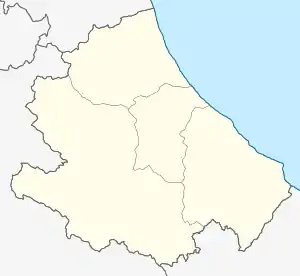Scanno, Abruzzo
Scanno (Abruzzese: Scannë) is a town and district in the province of L'Aquila, in the Abruzzo region of central Italy. It is a member of the I Borghi più belli d'Italia ("The most beautiful villages of Italy") association.[3]
Scanno | |
|---|---|
| Comune di Scanno | |
._Panoramica_diurna.jpg.webp) | |
Location of Scanno | |
 Scanno Location of Scanno in Italy  Scanno Scanno (Abruzzo) | |
| Coordinates: 41°54′7″N 13°53′4″E | |
| Country | Italy |
| Region | Abruzzo |
| Province | L'Aquila (AQ) |
| Frazioni | Frattura |
| Government | |
| • Mayor | Giovanni Mastrogiovann |
| Area | |
| • Total | 134.68 km2 (52.00 sq mi) |
| Elevation | 1,050 m (3,440 ft) |
| Population (28 February 2015)[2] | |
| • Total | 1,883 |
| • Density | 14/km2 (36/sq mi) |
| Demonym | Scannesi |
| Time zone | UTC+1 (CET) |
| • Summer (DST) | UTC+2 (CEST) |
| Postal code | 67038 |
| Dialing code | 0864 |
| Patron saint | St. Eustace |
| Saint day | 20 September |
| Website | Official website |
The town is bordered by Anversa degli Abruzzi, Barrea, Bisegna, Bugnara, Civitella Alfedena, Introdacqua, Opi, Pescasseroli, Pettorano sul Gizio, Rivisondoli, Rocca Pia, Villalago and Villetta Barrea.
History
Situated in the Sagittario Valley and encircled by the Majella mountains, Scanno has been immortalised by photographers Henri Cartier-Bresson (1951) and Mario Giacomelli (1957–59) and, according to Edward Lear, was host to Italy's most beautiful women.[4]
Local legend has it that Scanno's natural lake (Lago di Scanno - stocked with pike and perch and Abruzzo’s largest natural basin) was created by a feud between a white witch and a sorcerer; the lake marking the spot where the witch finally fell.
People
For a brief period during World War II, future Italian president Carlo Azeglio Ciampi was a refugee in the town.
Quinto Mancini (1893–1963), the father of American composer Henry Mancini, was born in Scanno on 13 March 1893 and later emigrated to America.
Main sites
- Hermitage of Sant'Egidio
- Sant'Antonio da Padova
- Santa Maria della Valle or Chiesa Matrice
- Madonna di Constatinopoli
References
- "Superficie di Comuni Province e Regioni italiane al 9 ottobre 2011". Italian National Institute of Statistics. Retrieved 16 March 2019.
- All demographics and other statistics: Italian statistical institute Istat.
- "Abruzzo" (in Italian). Retrieved 1 August 2023.
- Lear, Edward (1846). Illustrated excursions in Italy.